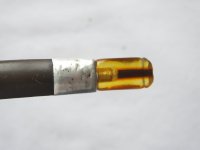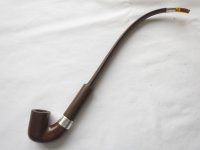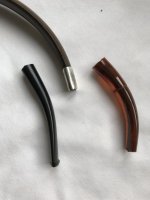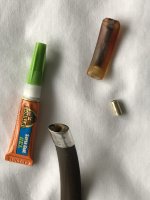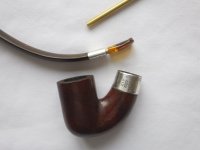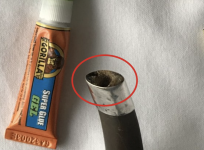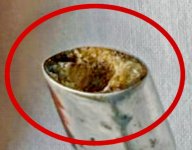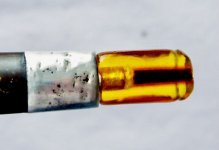Hello there.
This lovely old, 19th., C., Peterson reading pipe arrived in stock recently. I knew when I bought it there was a problem with the button because the original stem would have extended right through to it. Obviously someone had lost the button and had the pipe repaired. On closer inspection a replacement amber button had also broken off. What to do next?
I had four choices. Leave it alone, butcher another Peterson, try and fashion a new button from a briar stem or, possibly, fashion a new amber piece from one of my old broken stems. I didn't like the first three options but had always had difficulty with amber because its so brittle. I had to think outside the box a bit.
I decided I needed to use a brass tube plug to join a new button onto the residual amber inside the silver band. I had a 4.5mm tube to hand and a piece of old amber with a smaller hole in it. In the past when I've tried to drill amber it's shattered. So I put a 4.5mm drill bit in my cordless, got out the gas torch, heated the tip of the drill till it was bright red and then tried to enlarge the hole in the amber. It worked! I knew it was amber because it smelt like pine when the bit went in.
OK, so now the hole was made I could match it in the pipe and cut a length of tube to join them up. However we still had to shape and shorten the piece of amber. I used two machines for this, a disc and a bobbin sander, (it's handy working with wood and having this kit available). With care I made my first attempt. no bad but I decided it was too long. Chopped a bit off, thinned it down and reshaped it. This done I then used a series of diminishing grade sand paper to finish off and finally cleaned up with some very fine steel wool, Job done.
The short tube was fixed into the button with some supper glue and the amber sprayed with a satin lacquer finish. Once set this assembly was then fixed in place with more super glue and the replacement repair was complete.
Hope you found this interesting.
This lovely old, 19th., C., Peterson reading pipe arrived in stock recently. I knew when I bought it there was a problem with the button because the original stem would have extended right through to it. Obviously someone had lost the button and had the pipe repaired. On closer inspection a replacement amber button had also broken off. What to do next?
I had four choices. Leave it alone, butcher another Peterson, try and fashion a new button from a briar stem or, possibly, fashion a new amber piece from one of my old broken stems. I didn't like the first three options but had always had difficulty with amber because its so brittle. I had to think outside the box a bit.
I decided I needed to use a brass tube plug to join a new button onto the residual amber inside the silver band. I had a 4.5mm tube to hand and a piece of old amber with a smaller hole in it. In the past when I've tried to drill amber it's shattered. So I put a 4.5mm drill bit in my cordless, got out the gas torch, heated the tip of the drill till it was bright red and then tried to enlarge the hole in the amber. It worked! I knew it was amber because it smelt like pine when the bit went in.
OK, so now the hole was made I could match it in the pipe and cut a length of tube to join them up. However we still had to shape and shorten the piece of amber. I used two machines for this, a disc and a bobbin sander, (it's handy working with wood and having this kit available). With care I made my first attempt. no bad but I decided it was too long. Chopped a bit off, thinned it down and reshaped it. This done I then used a series of diminishing grade sand paper to finish off and finally cleaned up with some very fine steel wool, Job done.
The short tube was fixed into the button with some supper glue and the amber sprayed with a satin lacquer finish. Once set this assembly was then fixed in place with more super glue and the replacement repair was complete.
Hope you found this interesting.
Attachments
Last edited by a moderator:







